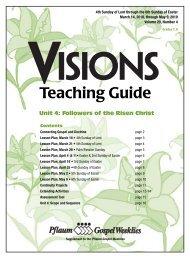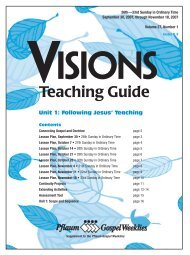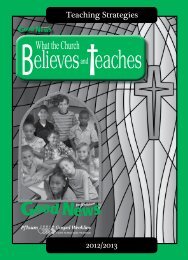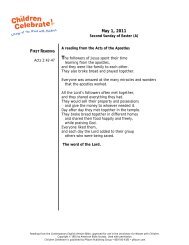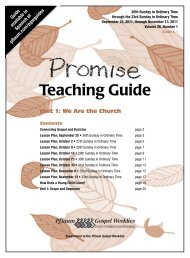Catechist Training Master 1 - Pflaum Home
Catechist Training Master 1 - Pflaum Home
Catechist Training Master 1 - Pflaum Home
You also want an ePaper? Increase the reach of your titles
YUMPU automatically turns print PDFs into web optimized ePapers that Google loves.
ecruiting and<br />
training catechists<br />
5Chapter<br />
Chapter<br />
Finding <strong>Catechist</strong>s<br />
Many parishes have a large<br />
turnover among catechists each<br />
year, but at the same time maintain<br />
a core of experienced catechists.<br />
Experienced catechists create<br />
stability in a program.<br />
A May appreciation party is a<br />
good time to sign up experienced<br />
catechists for another year. This<br />
event can be combined with an<br />
evaluation of the year. Honor<br />
catechists’ service and respond to<br />
their needs in order to form a group<br />
of able and experienced catechists<br />
who can not only teach children<br />
but also mentor new volunteer<br />
catechists. Some parishes pay their<br />
catechists modest stipends.<br />
Register children for religious<br />
education in August or preregister<br />
them in the spring, so you can<br />
determine how many children will<br />
be in your classes when they start<br />
in the fall. Class size is ideally<br />
between 10 and 20 children. New<br />
volunteer catechists succeed better<br />
with smaller groups.<br />
Begin recruiting catechists early.<br />
Involve the parish community<br />
by making your needs known.<br />
Consider:<br />
● Advertising in the parish<br />
bulletin;<br />
● Speaking from the pulpit;<br />
● Contacting potential recruits<br />
personally;<br />
● Offering a variety of ways<br />
parishioners can serve as<br />
catechists;<br />
● Requesting referrals from<br />
catechists, staff, and others;<br />
● Inviting new parishioners to<br />
join your team of catechists;<br />
● Allowing catechists to<br />
volunteer for a half-year or<br />
two months at a time and team<br />
teach in tandem with others;<br />
● Offering classes on different<br />
days, weekends, or at different<br />
times of day to allow more<br />
people to volunteer;<br />
● Holding classes in a different<br />
location than the parish<br />
buildings;<br />
● Offering the opportunity<br />
to team teach with another<br />
catechist for those who do not<br />
want to take on a class alone;<br />
● Partnering new volunteer<br />
catechists with experienced<br />
teachers for a year before they<br />
teach solo with children;<br />
● Having couples or teams teach<br />
classes rather than individuals<br />
teaching alone, or have teens<br />
work as aides with catechists to<br />
help with activities;<br />
● Creating a list of substitute<br />
catechists to call when regular<br />
catechists can’t make their<br />
classes.<br />
23<br />
Using Parish Talent and<br />
Resources<br />
To enhance your program,<br />
consider ways in which you can use<br />
parishioners’ creative resources to<br />
complement the lessons or themes<br />
of the liturgical seasons. Music,<br />
art, and puppets all offer additional<br />
avenues for learning our Christian<br />
tradition. For example, public<br />
schools no longer teach religious<br />
Christmas songs, so parishes should<br />
take up this tradition.<br />
Many people no longer attend<br />
the Holy Thursday, Good Friday,<br />
and Easter Vigil liturgies because<br />
they are working and not under<br />
any obligation to attend. Yet these<br />
celebrations, which involve the<br />
whole person with signs, symbols,<br />
music, and dramatic gestures, have<br />
more to teach children through their<br />
senses than any other liturgies of the<br />
year. The Weeklies strongly urge<br />
parishes to recatechize adults on the<br />
value of participating in the liturgies<br />
of the Sacred Triduum.<br />
● What special gifts do people in<br />
your parish have to bring to the<br />
religious education program?<br />
● Can you draw on parish<br />
musicians to teach songs to<br />
the young people regularly<br />
or for special seasons or for<br />
occasions such as the end of<br />
the year?
● Do you have storytellers who<br />
might do Gospel storytelling<br />
at the Seeds prereading<br />
level or who might use their<br />
storytelling abilities to enhance<br />
the children’s stories found<br />
in all of the <strong>Pflaum</strong> Gospel<br />
Weeklies editions?<br />
● Do you have puppeteers who<br />
can help children tell the<br />
Gospel with puppets?<br />
● Can you draw on someone who<br />
knows birds and flowers and<br />
might lead children on a nature<br />
walk?<br />
● What videos and music does<br />
your parish have that you can<br />
incorporate in the religious<br />
education program? What<br />
videos can you rent?<br />
<strong>Training</strong> Calendar<br />
<strong>Catechist</strong>s are not born. They<br />
develop through training and<br />
experience. The <strong>Pflaum</strong> Gospel<br />
Weeklies provide online Resource<br />
Manuals for each edition. These<br />
manuals are every catechist’s<br />
primary training tool. They provide<br />
background for catechists in the<br />
faith development of children, and<br />
the design and flow of each lesson<br />
in the Weeklies.<br />
This chapter of the Handbook<br />
suggests three inservice training<br />
sessions with catechists each<br />
year and a concluding evaluation/<br />
celebration session.<br />
<strong>Catechist</strong> Inservice Session 1:<br />
Orientation<br />
<strong>Catechist</strong> Inservice Session 2:<br />
Advent/Christmas: Exploring the<br />
Incarnation Mystery<br />
<strong>Catechist</strong> Inservice Session 3:<br />
Lent/Easter: Exploring the<br />
Paschal Mystery<br />
Evaluation and Celebration<br />
Drawing on the online Resource<br />
Manuals for training and discussion<br />
content, this chapter provides the<br />
resources the DRE needs to become<br />
the catechist to his or her catechists.<br />
<strong>Catechist</strong>s’ Needs<br />
If the parish has experience<br />
using the Weeklies, the director<br />
must both meet the needs of new<br />
catechists and survey experienced<br />
catechists to identify their evolving<br />
needs. A director can draw<br />
experienced catechists into training<br />
and mentoring new volunteers<br />
and into helping one another learn<br />
new techniques. For example,<br />
a primary-level catechist who is<br />
a good storyteller or who uses<br />
creative drama effectively can help<br />
others develop these valuable ways<br />
of involving children in their own<br />
learning.<br />
Orientation of new volunteer<br />
catechists usually includes:<br />
● the flow of a <strong>Pflaum</strong> Gospel<br />
Weeklies lesson;<br />
● the management of class time<br />
and space;<br />
● guidelines regarding discipline,<br />
attendance, use of the building,<br />
and other expectations and<br />
responsibilities.<br />
When a parish shifts for the first<br />
time into a liturgical catechesis<br />
approach, the director needs to<br />
familiarize all catechists and parents<br />
with the aims and resources of<br />
the new program. Experienced<br />
catechists benefit from overviewing<br />
how the <strong>Pflaum</strong> Gospel Weeklies<br />
provide the elements of basic,<br />
comprehensive catechesis. They<br />
usually want to know where they<br />
offer lessons on concepts that they<br />
are used to teaching, such as Old<br />
Testament, Commandments,<br />
prayers, and Sacraments.<br />
All teachers, catechists, and<br />
parents need ongoing help<br />
internalizing the doctrinal themes of<br />
the liturgical year. Each inservice<br />
session should include time to<br />
identify the doctrinal themes of the<br />
24<br />
liturgical seasons that upcoming<br />
Weeklies explore.<br />
Tailoring Inservice<br />
Sessions<br />
Directors have the role of suiting<br />
inservice sessions to the specific<br />
needs of their catechists. This<br />
Handbook describes three inservice<br />
sessions, which can work in any<br />
of the implementation models that<br />
earlier Handbook chapters describe.<br />
Depending on the needs of those<br />
using the <strong>Pflaum</strong> Gospel Weeklies<br />
the director can plan training<br />
sessions for:<br />
1. Total group;<br />
2. Grade- or edition-level groups;<br />
3. Self-directed groups in which<br />
catechists work together;<br />
4. High-interest presentations by<br />
outside specialists.<br />
The important part of catechist<br />
training—and this also applies to<br />
training parents as catechists of their<br />
children—is to ensure that your<br />
catechists meet and exchange ideas<br />
with you and with one another, that<br />
they meet in smaller groups to plan<br />
especially for the edition levels<br />
they teach, and that they learn more<br />
about special topics.<br />
Inservice Topics<br />
Each online Resource Manual<br />
offers a menu of possible topics<br />
for inservice presentations. This<br />
Handbook provides training masters<br />
for those topics, especially useful<br />
for the first year of the liturgical<br />
catechesis approach. Directors<br />
can use the menu to create their<br />
own inservice sessions to respond<br />
to the needs of their catechists in<br />
subsequent years of implementation.
Overview of <strong>Training</strong> Sessions<br />
<strong>Catechist</strong> <strong>Training</strong> <strong>Master</strong> 1 (page 30)<br />
The Flow of a Weeklies Lesson<br />
Use Chapter 2 of the appropriate edition-level<br />
online Resource Manual with this <strong>Catechist</strong><br />
<strong>Training</strong> <strong>Master</strong>.<br />
<strong>Catechist</strong> <strong>Training</strong> <strong>Master</strong> 2 (page 31)<br />
Liturgical Catechesis<br />
Use Chapter 2 of this Handbook with this<br />
<strong>Catechist</strong> <strong>Training</strong> <strong>Master</strong>.<br />
<strong>Catechist</strong> <strong>Training</strong> <strong>Master</strong> 3 (page 32)<br />
How Do Children at Each <strong>Pflaum</strong> Edition<br />
Level Learn?<br />
Use Chapter 1 of the appropriate edition-level<br />
online Resource Manual with this <strong>Catechist</strong><br />
<strong>Training</strong> <strong>Master</strong>.<br />
<strong>Catechist</strong> <strong>Training</strong> <strong>Master</strong> 4 (page 33)<br />
How Does the Liturgical Catechesis<br />
Approach of the Weeklies Provide<br />
Catholic Instruction?<br />
Use Chapters 2 and 3 of this Handbook with<br />
this <strong>Catechist</strong> <strong>Training</strong> <strong>Master</strong>.<br />
<strong>Catechist</strong> <strong>Training</strong> <strong>Master</strong> 5 (page 34)<br />
Nine Steps to Maintaining Order and<br />
Organization<br />
Use Chapter 3 of the appropriate editionlevel<br />
online Resource Manual with this<br />
<strong>Catechist</strong> <strong>Training</strong> <strong>Master</strong>.<br />
<strong>Catechist</strong> <strong>Training</strong> <strong>Master</strong> 6 (page 35)<br />
<strong>Pflaum</strong> Gospel Weeklies Evaluation<br />
Prayer Services<br />
Prayer Service 1 (page 36)<br />
The Sower and the Seed<br />
Prayer Service 2 (page 37)<br />
The Way of the Lord<br />
Prayer Service 3 (page 38)<br />
The Grain of Wheat<br />
Prayer Service 4 (page 39)<br />
“And to Some the Gift of Teaching”<br />
25
Suggested Calendar for the <strong>Pflaum</strong> Gospel Weeklies Year<br />
Time of <strong>Catechist</strong> Meetings Class Sessions Special<br />
Year and Family Activities Celebrations<br />
August<br />
<strong>Catechist</strong> <strong>Training</strong> Session 1: Orientation<br />
Introduce liturgical catechesis and the flow of a<br />
<strong>Pflaum</strong> Gospel Weeklies lesson. Distribute first eight<br />
<strong>Pflaum</strong> Gospel Weeklies lessons to catechists.<br />
Prayer Service 1:<br />
The Sower and the Seed<br />
Late August<br />
Meet with families, or send letter to parents<br />
explaining program.<br />
Early<br />
September<br />
September,<br />
October, and<br />
November<br />
Consider using the <strong>Pflaum</strong> online<br />
lessons (pflaumweeklies.com/<br />
earlystart) for the September<br />
Sundays prior to the first lesson of<br />
the <strong>Pflaum</strong> Gospel Weeklies<br />
Autumn Ordinary Time<br />
Lessons 1-8<br />
Thanksgiving prayer services<br />
and related activities. See<br />
individual lessons of the<br />
current <strong>Pflaum</strong> Gospel<br />
Weeklies.<br />
Before<br />
Advent<br />
begins<br />
<strong>Catechist</strong> <strong>Training</strong> Session 2: Advent/Christmas:<br />
Exploring the Incarnation Mystery. Introduce<br />
themes of Advent/Christmas and Sundays of Winter<br />
Ordinary Time. Distribute the eight <strong>Pflaum</strong> Gospel<br />
Weeklies lessons—Feast of Christ the King into<br />
January. The rest of the lessons for Ordinary Time<br />
will come in the packet with the first Sunday of Lent.<br />
Prayer Service 2:<br />
The Way of the Lord<br />
Advent/<br />
Christmas<br />
Winter<br />
Ordinary<br />
Time<br />
Christ the King, Advent/Christmas<br />
Lessons 9-16. Depending on the<br />
date of Easter, Winter Ordinary<br />
Time has as few as five or as many<br />
as nine Sundays.<br />
Christmas plays, programs,<br />
and prayer services are in<br />
individual lessons of the<br />
current <strong>Pflaum</strong> Gospel<br />
Weeklies.<br />
Before Lent<br />
Lent<br />
Easter<br />
Pentecost<br />
<strong>Catechist</strong> <strong>Training</strong> Session 3: Lent/Easter: Exploring<br />
the Paschal Mystery. Introduce themes of Lent and<br />
Eastertide using the Teacher/Parent Guide and unit<br />
overviews. Distribute the <strong>Pflaum</strong> Gospel Weeklies<br />
lessons for Lent. Send a parent letter summarizing<br />
the thrust of the Lent/Easter catechesis or meet with<br />
families.<br />
Lent/Triduum<br />
The Lent lessons include activities<br />
for the celebration of the Holy<br />
Week days.<br />
Prayer Service 3:<br />
The Grain of Wheat<br />
Ash Wednesday prayer<br />
service, class or all-school<br />
reconciliation service,<br />
Triduum liturgies, Passover<br />
meal<br />
Early May<br />
Send a letter to parents, alerting them to the end of<br />
the formal catechetical meetings for the school year.<br />
Eastertide: The number of lessons<br />
after Easter varies according to the<br />
date of Easter.<br />
Pentecost prayer services<br />
End of the<br />
catechetical<br />
sessions<br />
Evaluation and Celebration<br />
Use <strong>Training</strong> <strong>Master</strong> 6 as a way for your catechists to<br />
evaluate the catechesis and their experience.<br />
26<br />
Consider using the <strong>Pflaum</strong> online<br />
lessons (pflaumweeklies.com/<br />
lateclose) for the May Sundays<br />
after the last lessons of the <strong>Pflaum</strong><br />
Gospel Weeklies.<br />
Prayer Service 4:<br />
“And to Some the Gift of<br />
Teaching”<br />
©2013 <strong>Pflaum</strong> Publishing Group, Dayton, OH 45439 Permission to reproduce this page is granted for use in your religious education program.
<strong>Catechist</strong> <strong>Training</strong> Session 1<br />
Orientation<br />
Preparation<br />
1. Send a letter of invitation to each catechist or<br />
parent well in advance of the meeting date.<br />
2. Collect and duplicate inservice materials you will<br />
need for the meeting:<br />
● Calendar for the year and room assignment chart;<br />
● Provide link to online Resource Manual for each<br />
catechist;<br />
● Scope and Sequence Chart (wall chart);<br />
● Scope and Sequence Chart for the current year<br />
found in the User’s Guide;<br />
● Weeklies’ first lessons at each level and<br />
accompanying Teaching Guides;<br />
● Lesson planning forms for each catechist<br />
(<strong>Training</strong> <strong>Master</strong> 1);<br />
● Liturgical Catechesis (<strong>Training</strong> <strong>Master</strong> 2);<br />
● The Sower and the Seed Prayer Service<br />
(Prayer Service 1);<br />
Session 1: Orientation<br />
1. Welcome<br />
● Affirmation of catechists, parents<br />
● Introductions<br />
2. Prayer Service 1: The Sower and the Seed<br />
3. Liturgical Catechesis<br />
● <strong>Training</strong> <strong>Master</strong> 2<br />
● Handbook Chapter 2<br />
4. The Flow of a <strong>Pflaum</strong> Gospel Weeklies<br />
Lesson<br />
● <strong>Catechist</strong> <strong>Training</strong> <strong>Master</strong> 1<br />
● Resource Manuals, Chapter 2.<br />
● The first eight lessons of the Weeklies and their<br />
Teaching Guides<br />
Break for Refreshments<br />
● Nine Steps to Maintaining Order and Organization<br />
(<strong>Catechist</strong> <strong>Training</strong> <strong>Master</strong> 5);<br />
Help your catechists or parents find the description<br />
of each part of a lesson in the online Resource<br />
Manual for their edition. Have them find the same<br />
parts for each grade level in the Weeklies and in the<br />
Teaching Guide. Enlist experienced catechists to<br />
work through the lesson plan with new catechists and<br />
parent catechists by edition level.<br />
3. Create supply boxes for each catechist or<br />
classroom. See Resource Manuals online.<br />
4. Prepare to lead a session such as the one outlined<br />
below. The agenda suggests addressing the needs<br />
of new and experienced catechists separately.<br />
Conclude by regathering as a total group to discuss<br />
what it means to be a catechist, to review the<br />
calendar for the year, and to answer questions.<br />
New <strong>Catechist</strong> Session<br />
Managing Class Time, Space, and Children<br />
● Resource Manuals, Chapter 3.<br />
● <strong>Catechist</strong> <strong>Training</strong> <strong>Master</strong> 5: Discipline<br />
● Partner with experienced catechists<br />
Experienced <strong>Catechist</strong> Session<br />
Doctrinal Themes of Autumn Ordinary Time<br />
● The first eight lessons of the Weeklies and their<br />
Teaching Guides<br />
● Scope and Sequence Chart (wall chart) and<br />
Scope and Sequence Chart for the current year<br />
Total Group<br />
● Form small groups and discuss the key factors<br />
in being a catechist. Gather the large group and<br />
list on the chalkboard or newsprint all key ideas<br />
and thoughts that came from the small group<br />
discussion.<br />
● Review calendar for the year.<br />
● Take questions.<br />
27
<strong>Catechist</strong> <strong>Training</strong> Session 2<br />
Advent/Christmas: Exploring the Incarnation Mystery<br />
Preparation<br />
Collect and duplicate inservice materials you will<br />
need for the meeting:<br />
● Weeklies second set of lessons at each level and<br />
accompanying Teaching Guides;<br />
● Eight lesson planning forms for each catechist<br />
(<strong>Catechist</strong> <strong>Training</strong> <strong>Master</strong> 1);<br />
● Provide link to the online Resource Manual for<br />
each catechist;<br />
● The Way of the Lord (Prayer Service 2);<br />
● How Do Children at Each <strong>Pflaum</strong> Gospel<br />
Weeklies Level Learn? (<strong>Catechist</strong> <strong>Training</strong><br />
<strong>Master</strong> 3).<br />
Session 2: Exploring the Incarnation Mystery<br />
l. Greeting and Introductions<br />
2. Prayer Service 2: The Way of the Lord<br />
3. How Do Children at Each <strong>Pflaum</strong> Gospel<br />
Weeklies Level Learn?<br />
● <strong>Catechist</strong> <strong>Training</strong> <strong>Master</strong> 3<br />
● Resource Manuals, Chapter 1<br />
4. Doctrinal Themes of Second set of Lessons<br />
● Second set of lessons of the Weeklies and their<br />
Teaching Guides<br />
● Handbook Chapter 2<br />
● Three-Year Scope and Sequence<br />
Chart (wall chart)<br />
● Scope and Sequence Chart for the current year<br />
5. Lesson Planning<br />
Divide into five groups, according to which<br />
<strong>Pflaum</strong> Gospel Weeklies each person uses.<br />
Distribute lessons and lesson plan blanks. Have<br />
an experienced leader in each group help the<br />
group prepare a lesson plan for the 1st Sunday of<br />
Advent, adapting the lesson plans sugggested in<br />
the guides to the time available and other specific<br />
circumstances.<br />
6. Large Group<br />
Gather as a large group to decide on activities, from<br />
the Advent/Christmas lessons, that you may wish to<br />
use in all-school or all-religion-classes Christmas<br />
programs.<br />
7. Review Calendar<br />
Ask for questions about any aspect of the program.<br />
Take time to make sure your answers satisfy. If<br />
there are concerns that need more attention, put<br />
them on the next meeting agenda.<br />
28
<strong>Catechist</strong> <strong>Training</strong> Session 3<br />
Lent/Easter: Exploring the Paschal Mystery<br />
Preparation<br />
Collect and duplicate inservice materials you will<br />
need for the meeting:<br />
● The Grain of Wheat (Prayer Service 3);<br />
● Weeklies third set of lessons at each level and<br />
accompanying Teaching Guides;<br />
● Eight lesson planning forms for each catechist<br />
(<strong>Catechist</strong> <strong>Training</strong> <strong>Master</strong> 1);<br />
● How Does the Liturgial Catechesis Approach of the<br />
Weeklies Provide Catholic Instruction? (<strong>Catechist</strong><br />
<strong>Training</strong> <strong>Master</strong> 4);<br />
● Provide link to the Resource Manuals;<br />
● Three-Year Scope and Sequence Chart<br />
Session 3: Exploring the Paschal Mystery<br />
1. Welcome<br />
2. Prayer Service 3: The Grain of Wheat<br />
3. How Does the Liturgical Catechesis<br />
Approach of the Weeklies Provide Catholic<br />
Instruction?<br />
● Handbook Chapter 2<br />
● Three-Year Scope and Sequence<br />
Chart (wall chart)<br />
● Scope and Sequence Chart for the current year<br />
4. The Doctrinal Themes of Third set of<br />
Lessons<br />
● Handbook Chapter 2<br />
● Scope and Sequence Charts<br />
● Third set of lessons of the Weeklies and their<br />
Teaching Guides<br />
6. Large Group<br />
Gather as a large group to decide on activities<br />
from the Lent lessons which you may wish to<br />
consider for use in all-school or all-religion-classes<br />
celebration of Ash Wednesday and the Holy<br />
Triduum. Consider ways to involve families and<br />
their children in the liturgies of Holy Week.<br />
7. Review Calendar<br />
Ask for questions about any aspect of the program.<br />
Take time to make sure your answers satisfy. Note<br />
that the next catechist meeting will be the last.<br />
5. Lesson Planning<br />
Divide into five groups, according to which <strong>Pflaum</strong><br />
Gospel Weeklies each person teaches. Distribute<br />
lessons and lesson plan blanks. Have catechists<br />
work together to overview the upcoming lessons.<br />
29
The Flow of a Weeklies Lesson<br />
<strong>Catechist</strong> <strong>Training</strong> <strong>Master</strong> 1<br />
LLESSON PLAN STEPS PURPOSE, OBJECTIVES TIME MATERIALS<br />
NEEDED NEEDED<br />
1. Sharing Life Stories<br />
Liturgy of the Word Ritual<br />
Cover Activity<br />
Story or Article<br />
Discussion Questions<br />
2. Listening to God’s Word<br />
Proclaiming the Gospel<br />
• Reflecting on the Gospel<br />
Discussion Questions<br />
• Linking Story and Gospel<br />
3. Building Christian Community<br />
Gospel Activity<br />
Bible and Liturgy Features<br />
Doctrine<br />
Concluding Prayer<br />
Use with Resource Manuals, Chapter 2, and weekly Teaching Guides.<br />
30<br />
©2013 <strong>Pflaum</strong> Publishing Group, Dayton, OH 45439 Permission to reproduce this page is granted for use in your religious education program.
Liturgical Catechesis<br />
1. Define “lectionary”:<br />
<strong>Catechist</strong> <strong>Training</strong> <strong>Master</strong> 2<br />
2. Talk about liturgical catechesis and its relationship to the liturgical year:<br />
3. List the liturgical seasons and show how your catechetical schedule follows the seasons:<br />
Use the questions on this page to explore and discuss liturgical catechesis (Handbook Chapter 2).<br />
Read the chapter and discuss the questions in small groups.<br />
31<br />
©2013 <strong>Pflaum</strong> Publishing Group, Dayton, OH 45439 Permission to reproduce this page is granted for use in your religious education program.
How Do Children at Each <strong>Pflaum</strong><br />
Gospel Weeklies Level Learn?<br />
Child Development Levels<br />
Seeds<br />
● eager learners<br />
● egocentric<br />
● physically vigorous/tire quickly<br />
● strong imaginations/interact with senses<br />
● need parental involvement<br />
Seeds presents the stories of Jesus in creative and<br />
engaging ways that enable preschoolers to share in the<br />
faith of the Christian community and to experience<br />
Jesus’ love in their everyday lives.<br />
Promise<br />
● hands-on learners<br />
● full of wonder/energy/noisy<br />
● share family faith<br />
● abstract thinking<br />
Promise helps catechists present the Gospel stories in<br />
a loving atmosphere and use hands-on ways to involve<br />
the children in those stories.<br />
Good News<br />
● concrete thinkers and learners<br />
● storytellers<br />
● first Eucharist<br />
Good News for Children helps second- and thirdgraders<br />
hear and retell the Gospel stories and use their<br />
senses to learn about their world.<br />
Venture<br />
● industrious data-gatherers<br />
● concrete thinkers<br />
● sense of moral reasoning<br />
● developing historical sense<br />
● enjoy doing projects together/time and space<br />
● able to use symbols<br />
<strong>Catechist</strong> <strong>Training</strong> <strong>Master</strong> 3<br />
Venture works with the abilities of middle-graders,<br />
who still think concretely but love to work together on<br />
elaborate projects.<br />
Visions<br />
● emotional and social development<br />
● maturing physically<br />
● new thnking capacity<br />
● wanting to belong to groups and make personal<br />
friends<br />
Visions leads junior-high students to stretch their<br />
developing abstract thinking skills and to apply them to<br />
going beyond the literal level of scripture stories.<br />
What thinking ability do the children at the age-level<br />
I teach possess?<br />
What are the moral reasoning abilities of the<br />
children I teach?<br />
How do the children I teach relate to one another<br />
and to others at their level of social development?<br />
What spiritual or faith development level can I<br />
expect of the young people I teach?<br />
Use this discussion aid with the appropriate levels of the Resource Manuals, Chapter 1. Read through the<br />
information on this page and work in groups that include catechists or parents from each of the five edition levels<br />
if possible. Have each person review the appropriate chapter in the Manual, make notes, and then report on and<br />
discuss what can be expected of a child at each age in terms of religion.<br />
32<br />
©2013 <strong>Pflaum</strong> Publishing Group, Dayton, OH 45439 Permission to reproduce this page is granted for use in your religious education program.
How Does the Liturgical Catechesis Approach of<br />
Weeklies Provide Catholic Instruction?<br />
1. Why is the lectionary called a privileged source of catechesis?<br />
<strong>Catechist</strong> <strong>Training</strong> <strong>Master</strong> 4<br />
2. How is liturgical catechesis both Christocentric and Trinitarian, and why is this important to Catholic<br />
instruction?<br />
3. Liturgical catechesis is richly scriptural. Talk about the major themes of scripture you will be studying<br />
with this approach.<br />
4. How are the aims of conversion and praxis in the liturgical approach of the <strong>Pflaum</strong> Gospel Weeklies<br />
different from the aim of simply understanding religious concepts?<br />
Use these questions to explore and discuss Chapters 2 and 3 in the Handbook. See also the Scope and<br />
Sequence Chart.<br />
33<br />
©2013 <strong>Pflaum</strong> Publishing Group, Dayton, OH 45439 Permission to reproduce this page is granted for use in your religious education program.
Nine Steps to Maintaining Order and Organization<br />
Step 1: Focus attention. Sister Ann begins class<br />
the same way each day, “Boys and girls,” she says,<br />
almost in a whisper, “stare at me.” Sister knows what<br />
she’s doing. Follow her example and get everyone’s<br />
attention before you begin a lesson. Invite the<br />
children to gather and to settle down. Then wait in<br />
silence until they do so. Your silence can be very<br />
effective. If someone is disrupting class by talking,<br />
don’t attempt to talk over him or her, simply be silent,<br />
and your silence will focus attention on you.<br />
Step 2: Explain what’s about to happen. “Tell<br />
them what you’re going to tell them,” has always been<br />
sound advice for teachers. Outlining what you and<br />
the children will be doing in a lesson not only tells the<br />
children what the lesson will be about, but also gives<br />
them something to anticipate. Anticipation makes for<br />
eager learners.<br />
Step 3: Circulate as you catechize. A favorite<br />
teacher says he always like to move around the room<br />
when teaching. “It’s harder to hit a moving target,”<br />
he jokes. But moving about to monitor the classroom<br />
is no joke. While your students are working on their<br />
own or in small groups, roam the room. Check on<br />
progress and offer help where needed. Students not<br />
yet quite on task will be quick to get going as they see<br />
you approach. Children will appreciate your personal<br />
and positive attention.<br />
Step 4: Model the faith. Albert Schweitzer once<br />
said, “Example is not the main thing in influencing<br />
others. It’s the only thing.” In like manner, the<br />
General Directory for Catechesis reminds us that<br />
“faith is more witnessed to than taught” (GDC #255).<br />
Teachers and catechists who evidence the Christian<br />
virtues and model compassion and justice provide<br />
powerful examples for their students and discourage<br />
misbehavior.<br />
<strong>Catechist</strong> <strong>Training</strong> <strong>Master</strong> 5<br />
Step 5: Control the environment. Strive to make<br />
your meeting space a warm, cheery place. Change the<br />
environment with the seasons—natural and liturgical.<br />
Pay attention to how your students react to the<br />
environment—too bland? Too spicy? See to it that<br />
the environment inspires order not disorder.<br />
Step 6: Accentuate the positive. Refuse to<br />
reward rowdiness. Don’t give a disruptive student<br />
any more of what he or she is craving—attention. If<br />
a student acts up, respond in a low-key manner, then<br />
calmly focus the child’s attention on the behavior you<br />
expect from him or her, not on the misbehavior, “I<br />
need you to...” or “I expect you to...”<br />
Step 7: Deliver “I” messages. Should the<br />
misbehaving continue, respond by describing (1) the<br />
problem behavior: “When you talk while I talk...”<br />
(2) the effect the behavior has on you or the class<br />
“... I don’t have time to help others...” (3) the feeling<br />
that the misbehavior generates in you “... I feel very<br />
frustrated.”<br />
Step 8: Expect the best. Use classroom guidelines<br />
that describe the behaviors you want, not those you<br />
don’t want. Instead of “no-gum chewing,” use “leave<br />
gum at home.” Instead of “no put-downs,” use “show<br />
respect for others.”<br />
Step 9: Catch students behaving. Be generous<br />
with praise. When you witness good behavior,<br />
acknowledge it. A kind word, a nod, a smile, a highfive,<br />
or a thumbs-up reinforces the behavior.<br />
Use these steps to explore and discuss concerns catechists may have about discipline in the classroom. See the<br />
Resource Manuals, Chapter 3. Experienced catechists can share ideas and techniques with new catechists.<br />
34<br />
©2013 <strong>Pflaum</strong> Publishing Group, Dayton, OH 45439 Permission to reproduce this page is granted for use in your religious education program.
<strong>Pflaum</strong> Gospel Weeklies Evaluation<br />
<strong>Catechist</strong> <strong>Training</strong> <strong>Master</strong> 6<br />
1. What aspect of the <strong>Pflaum</strong> Gospel Weeklies were you most hopeful about at the beginning? How has it<br />
succeeded?<br />
2. What problem were you most concerned about? How did it turn out?<br />
3. What elements of the Weeklies did you enjoy working with most?<br />
4. What elements did your students enjoy working with most?<br />
5. Which parts of the training were most helpful to you? Which were of little importance and need to be<br />
improved?<br />
6. How well do you feel the Weeklies’ liturgical catechesis fit with the catechetical guidelines outlined by<br />
the Catechism of the Catholic Church?<br />
7. In what ways did the Handbook and the online Resource Manual help you? (Check all that apply.)<br />
___ Explained the concept of liturgical catechesis (Handbook)<br />
___ Helped me see how a Weeklies lesson flowed (Resource Manual)<br />
___ Helped me with classroom organization and management (Resource Manual)<br />
___ Other ____________________________________________________________________________<br />
_________________________________________________________________________________<br />
8. Are you satisfied with student attendance and morale? Why or why not?<br />
9. Are you satisfied with parents’ support of the program? Why or why not?<br />
10. What have been your best accomplishments of this teaching year?<br />
11. What are your two best recommendations to make our religious education more effective?<br />
35<br />
©2013 <strong>Pflaum</strong> Publishing Group, Dayton, OH 45439 Permission to reproduce this page is granted for use in your religious education program.
<strong>Catechist</strong> Prayer Service 1<br />
OPENING SONG: Choose a song the group is familiar<br />
with.<br />
OPENING PRAYER: In every generation sowers<br />
must sow anew the seed that is the Word of God. In<br />
the parable of the sower, Jesus tells us some seed never<br />
sprouts, some withers, some gets choked out by weeds,<br />
but some falls on good ground and yields thirty, sixty,<br />
and a hundredfold. Our ministry is to sow God’s Word<br />
in the good ground of young people’s lives.<br />
SIDE 1: Let us plant the seeds of a joyful God.<br />
SIDE 2: Let us plant the seeds of love and forgiveness.<br />
SIDE 1: Let us plant the seeds of joy and thankfulness.<br />
SIDE 2: Let us plant the seeds of empathy and<br />
compassion.<br />
LEADER: That the Word of God makes us sensitive to<br />
the hurts and pains of others, we pray to the Lord.<br />
ALL: May all the seeds we plant fall on good ground.<br />
LEADER: That the Word of God sings in our hearts<br />
and voices, we pray to the Lord.<br />
ALL: May all the seeds we plant fall on good ground.<br />
LEADER: Loving God, may we and those we teach<br />
be good ground in which your Word flourishes and<br />
yields thirty, sixty, and a hundredfold. Help the seeds of<br />
justice, love, and peace sprout in those we teach. Amen.<br />
SONG: Conclude with a song everyone knows.<br />
READING: Mark 4.1-8<br />
REFLECTION: Let us share what attitudes and values<br />
we want to sow this year by what we teach and by how<br />
we teach.<br />
Take time for participants to contribute.<br />
LEADER: That the Word of God leads us to action<br />
the service of God, we pray to the Lord.<br />
ALL: May all the seeds we plant fall on good ground.<br />
LEADER: That the Word of God helps us listen to all<br />
God’s children, we pray to the Lord.<br />
ALL: May all the seeds we plant fall on good ground.<br />
LEADER: That the Word of God takes all judgment<br />
of others from our hearts, we pray to the Lord.<br />
ALL: May all the seeds we plant fall on good ground.<br />
Our ministry<br />
is to sow<br />
God’s Word<br />
in the good ground<br />
of young people’s lives.<br />
36<br />
©2013 <strong>Pflaum</strong> Publishing Group, Dayton, OH 45439 Permission to reproduce this page is granted for use in your religious education program.
The Way of the Lord<br />
<strong>Catechist</strong> Prayer Service 2<br />
OPENING SONG: “O Come, O Come, Emmanuel,”<br />
or another Advent song familiar to the group.<br />
LEADER: Let us pray in the name of God who gives<br />
all things life and sustains the world, in the name of<br />
Jesus in whom God comes among us, and in the name<br />
of the Spirit who frees us for God’s work in this world.<br />
ALL: Amen.<br />
SIDE 1: By your creative power, God, you separated<br />
the waters of the heavens from the springs of<br />
the earth, the dry land from the sea.<br />
SIDE 2: For Israel enslaved in Egypt, the way of the<br />
Lord was a dry path through the Red Sea.<br />
SIDE 1: For Israel exiled in Babylon, the way of<br />
the Lord was a smooth, straight road home<br />
through the wilderness.<br />
SIDE 2: For us, the way of the Lord is Jesus’ coming<br />
among us and going before us through death<br />
to life.<br />
ADVENT WREATH BLESSING<br />
ALL: Amen.<br />
BLESSING 1: The circle of the wreath is a sign of<br />
God’s endless love for us. May we show one another<br />
love in our families and community.<br />
ALL: Loving God, listen to our prayer.<br />
BLESSING 2: The candles mark the weeks of Advent<br />
with your holy light, Lord. May we follow that light on<br />
our journey this Advent.<br />
ALL: Loving God, listen to our prayer.<br />
LEADER: The evergreen branches remind us that<br />
God sustains our lives in bountiful love. Help us to be<br />
thankful, God, for all your many gifts to us.<br />
ALL: Loving God, listen to our prayer.<br />
ALL: God of all the Ages, we often walk in darkness<br />
and fear the light. Advent is a time to turn toward your<br />
dawning in our world and remember your promises of<br />
life and love. Make us be people of loving and joyful<br />
hearts. Help us reach out to others in need. Keep us<br />
open and alive to your love. Amen.<br />
LEADER: Advent is a time for preparing for<br />
the birth of Jesus. We await Jesus’ coming<br />
with faith and hope. Bless this wreath and<br />
the light it bears. Let us prepare our hearts<br />
by using the symbol of the wreath to<br />
reflect on our past, live in the present, and<br />
hope in the future.<br />
37<br />
©2013 <strong>Pflaum</strong> Publishing Group, Dayton, OH 45439 Permission to reproduce this page is granted for use in your religious education program.
The Grain of Wheat<br />
PREPARATION: Make five groups by having people<br />
number off from 1 to 5. Each group reads the words<br />
in the Grain of Wheat Prayer Service corresponding<br />
to their number. Prepare seeds and dirt for planting.<br />
Choose a familiar song of thanks to end the service.<br />
Add sound dimensions to the Gospel tone poem by<br />
asking individuals to make certain musical sounds each<br />
time certain words occur; for example, improvise with<br />
such simple sounds as these:<br />
solemnly (tap pencils together rapidly),<br />
falls (run a pencil down the spiral of a notebook),<br />
dies (drum softly on a hollow object),<br />
ground (crumple paper),<br />
eternal life (jingle key rings).<br />
LEADER: In the Gospel for the 5th Sunday of Lent,<br />
cycle B, Jesus compares himself to a grain of wheat.<br />
A grain of wheat indeed must fall into the earth to<br />
germinate. It does not really die. A seed that falls<br />
into the earth and dies does not sprout. Jesus’ image<br />
is one of transformation. In the seed that sprouts, the<br />
life within the seed bursts its hull and takes new form.<br />
Listen to this tone poem version of the Gospel. Let the<br />
sounds fall and flow over and around you. What life<br />
within you wants to burst its hull?<br />
The Grain of Wheat<br />
Gospel Tone Poem<br />
1 I tell you<br />
2 tell you<br />
3 solemnly tell you<br />
4 I tell you solemnly:<br />
5 Unless<br />
1 unless a grain<br />
2 I tell you solemnly<br />
3 unless a grain<br />
4 a grain of wheat<br />
5 unless it falls<br />
1 the wheat falls<br />
2 on the ground<br />
3 and dies,<br />
4 unless the wheat dies<br />
5 unless it falls on the ground<br />
1 it stays a single grain<br />
2 a single grain<br />
<strong>Catechist</strong> Prayer Service 3<br />
3 only grain<br />
4 lonely grain<br />
5 a single grain<br />
1 it stays forever<br />
2 forever alone<br />
3 a single grain of wheat.<br />
4 But if it dies<br />
5 if the wheat dies<br />
1 on the ground<br />
2 in the ground<br />
3 under the ground<br />
4 a single grain<br />
5 if it dies<br />
1 if a single grain dies,<br />
2 it yields<br />
3 it increases<br />
4 it multiplies<br />
5 it brings forth<br />
1 a single grain<br />
2 it brings forth<br />
3 from the ground<br />
4 it brings a rich<br />
5 a very rich<br />
1 an extremely rich<br />
2 a single grain brings forth<br />
3 a joyfully rich harvest<br />
4 many grains of wheat<br />
5 harvest of eternal life. John 12.24<br />
REFLECTION: Talk together about a seed within you<br />
that wants to burst its hull this Lent. How can each of<br />
us plant this seed and expect transforming growth?<br />
SIDE 1: Unless a grain of wheat falls into the earth, it<br />
remains a single grain.<br />
SIDE 2: But if it germinates, it yields a rich harvest.<br />
LEADER: Lead us through Lent to transformation,<br />
Jesus. We want to germinate, sprout, and yield a<br />
hundredfold. We want to be fruitful in ministering your<br />
Word to those we teach.<br />
ALL: We are your seed, Christ Jesus. Amen.<br />
SONG: Sing a familiar song.<br />
38<br />
©2013 <strong>Pflaum</strong> Publishing Group, Dayton, OH 45439 Permission to reproduce this page is granted for use in your religious education program.
“And to Some the Gift of Teaching”<br />
<strong>Catechist</strong> Prayer Service 4<br />
OPENING SONG: Sing a song familiar to the group.<br />
LEADER: We gather together in friendship and<br />
thanksgiving for the many gifts we have received this<br />
year. We have also been gifts—gifts to one another and<br />
to our parish community.<br />
ALL: In the name of the Father and of the Son and of<br />
the Holy Spirit. Amen.<br />
LEADER: Happy are the just; they are like trees<br />
planted near running water.<br />
ALL: That yield fruit in due season and whose leaves<br />
never fade.<br />
LEADER: The Gospel writer Mark tells us two stories<br />
about Jesus feeding multitudes. In these miracle stories,<br />
Jesus responds to the needs of large groups and, in both<br />
cases, the feedings result in an abundance of food left<br />
over. In our work as catechists this year we have seen<br />
miracles, too. We responded in love and kindness to our<br />
students and we fed them with the Word of God.<br />
READING: Mark 8.1-9<br />
REFLECTION: What times during the past year have<br />
I needed a miracle? What miracles have happened?<br />
LEADER: Jesus, you are the Bread of Life.<br />
ALL: Help us to walk with you always.<br />
LEADER: Jesus, you reached out and taught others<br />
about your Father.<br />
ALL: Help us to walk with you always.<br />
LEADER: Jesus, you nourished those who were<br />
hungry and weak.<br />
ALL: Help us to walk with you always.<br />
LEADER: Jesus, you taught us through your actions.<br />
ALL: Help us to walk with you always.<br />
LEADER: Thank you for this great year of teaching.<br />
Thank you for the many friends we have made and for<br />
the children we have taught. Keep us all safe and close<br />
to you. We ask this in Jesus’ name.<br />
ALL: Amen.<br />
Happy are the just; they<br />
are like trees planted near<br />
running water that yields<br />
fruit in due season and whose<br />
leaves never fade.<br />
Psalm 1.1, 3<br />
39<br />
©2013 <strong>Pflaum</strong> Publishing Group, Dayton, OH 45439 Permission to reproduce this page is granted for use in your religious education program.



